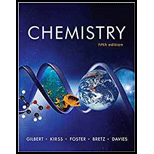
Concept explainers
(a)
Interpretation: The diatomic molecule whose bond order increases with the loss of two electrons is to be found from the given molecules.
Concept introduction: When two atomic orbitals come close to each other they lose their identity and form new pair of orbitals knows as molecular orbitals. Among the two molecular orbitals formed one has energy lower than the atomic orbitals is known as bonding molecular orbital and the other has energy higher than the atomic orbitals and is known as antibonding molecular orbital. The filling electrons in molecular orbitals follow Aufbau’s principle and Hund’s rule.
To determine: If the bond order of diatomic molecule
(a)
Answer to Problem 9.110QP
Solution
The bond order of
Explanation of Solution
Explanation
The electronic configuration of
The bond order for
The number of bonding electrons in
The number of antibonding electrons in
Substitute the value of number of electrons in bonding and antibonding orbitals in
The bond order of
The
The bond order of
The number of bonding electrons in
The number of antibonding electrons in
Substitute the value of number of electrons in bonding and antibonding orbitals in
The bond order of
Hence, the bond order of
(b)
To determine: If the bond order of diatomic molecule
(b)
Answer to Problem 9.110QP
Solution
The bond order of
Explanation of Solution
Explanation
The electronic configuration of
The bond order for
The number of bonding electrons in
The number of antibonding electrons in
Substitute the value of number of electrons in bonding and antibonding orbitals in
The bond order of
The
The bond order for
The number of bonding electrons in
The number of antibonding electrons in
Substitute the value of number of electrons in bonding and antibonding orbitals in
The bond order of
Hence, the bond order of
(c)
To determine: If the bond order of diatomic molecule
(c)
Answer to Problem 9.110QP
Solution
The bond order of
Explanation of Solution
Explanation
The electronic configuration of
The bond order for
The number of bonding electrons in
The number of antibonding electrons in
Substitute the value of number of electrons in bonding and antibonding orbitals in
The bond order of
The
The bond order for
The number of bonding electrons in
The number of antibonding electrons in
Substitute the value of number of electrons in bonding and antibonding orbitals in
The bond order of
Hence, the bond order of
(d)
To determine: The bond order of diatomic molecule
(d)
Answer to Problem 9.110QP
Solution
The bond order of
Explanation of Solution
Explanation
The electronic configuration of
The bond order for
The number of bonding electrons in
The number of antibonding electrons in
Substitute the value of number of electrons in bonding and antibonding orbitals in
The bond order of
he
The bond order for
The number of bonding electrons in
The number of antibonding electrons in
Substitute the value of number of electrons in bonding and antibonding orbitals in
The bond order of
Hence, the bond order of
Conclusion
Higher the bond order of a molecule higher will be its bond strength. The bond order of oxygen increases while as the bond order of boron, carbon and nitrogen molecules decreases with the loss of two electrons.
Want to see more full solutions like this?
Chapter 9 Solutions
CHEMISTRY:SCI.IN CONTEXT (CL)-PACKAGE
 ChemistryChemistryISBN:9781305957404Author:Steven S. Zumdahl, Susan A. Zumdahl, Donald J. DeCostePublisher:Cengage Learning
ChemistryChemistryISBN:9781305957404Author:Steven S. Zumdahl, Susan A. Zumdahl, Donald J. DeCostePublisher:Cengage Learning ChemistryChemistryISBN:9781259911156Author:Raymond Chang Dr., Jason Overby ProfessorPublisher:McGraw-Hill Education
ChemistryChemistryISBN:9781259911156Author:Raymond Chang Dr., Jason Overby ProfessorPublisher:McGraw-Hill Education Principles of Instrumental AnalysisChemistryISBN:9781305577213Author:Douglas A. Skoog, F. James Holler, Stanley R. CrouchPublisher:Cengage Learning
Principles of Instrumental AnalysisChemistryISBN:9781305577213Author:Douglas A. Skoog, F. James Holler, Stanley R. CrouchPublisher:Cengage Learning Organic ChemistryChemistryISBN:9780078021558Author:Janice Gorzynski Smith Dr.Publisher:McGraw-Hill Education
Organic ChemistryChemistryISBN:9780078021558Author:Janice Gorzynski Smith Dr.Publisher:McGraw-Hill Education Chemistry: Principles and ReactionsChemistryISBN:9781305079373Author:William L. Masterton, Cecile N. HurleyPublisher:Cengage Learning
Chemistry: Principles and ReactionsChemistryISBN:9781305079373Author:William L. Masterton, Cecile N. HurleyPublisher:Cengage Learning Elementary Principles of Chemical Processes, Bind...ChemistryISBN:9781118431221Author:Richard M. Felder, Ronald W. Rousseau, Lisa G. BullardPublisher:WILEY
Elementary Principles of Chemical Processes, Bind...ChemistryISBN:9781118431221Author:Richard M. Felder, Ronald W. Rousseau, Lisa G. BullardPublisher:WILEY





